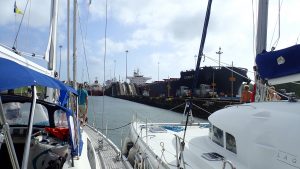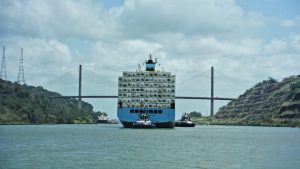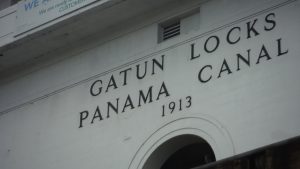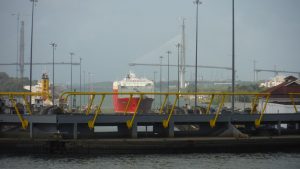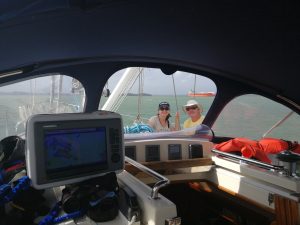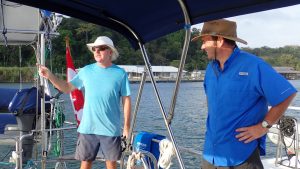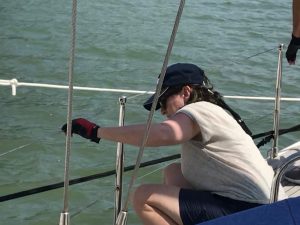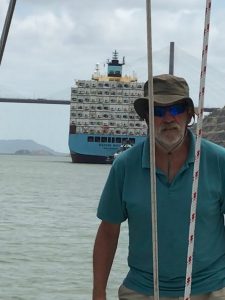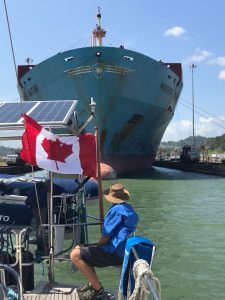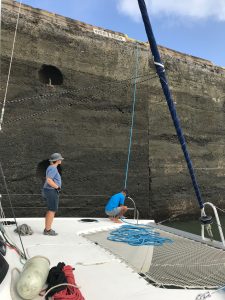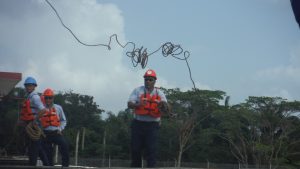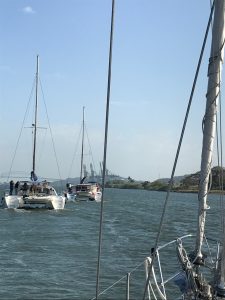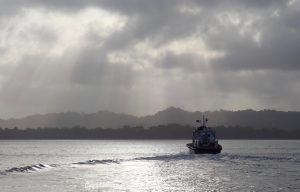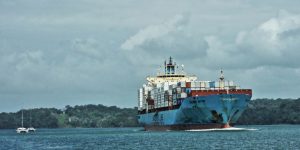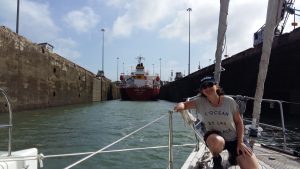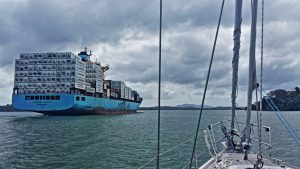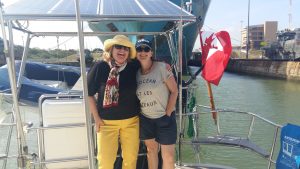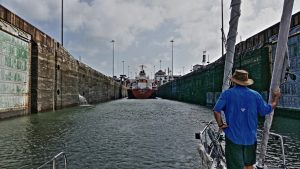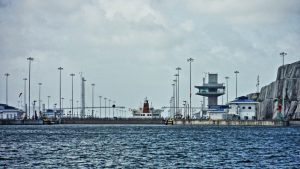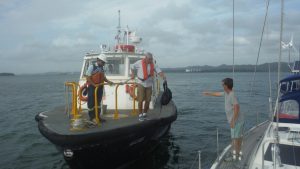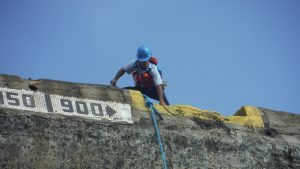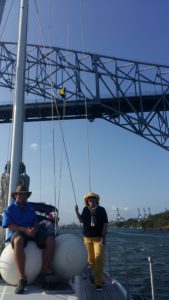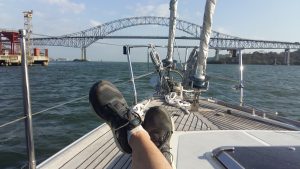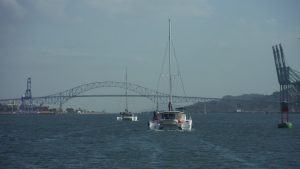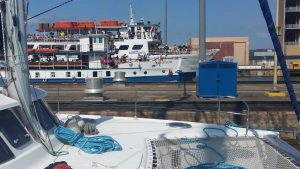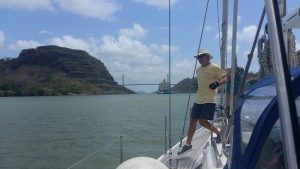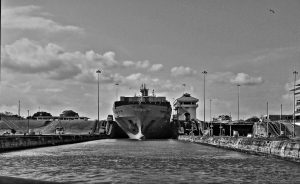Panama has a canal. You’ve probably heard of it, it’s quite famous. But have you heard it referred to as ‘The Chicken of Golden Eggs’? For Panamanians, the Canal is indeed the gift that keeps on giving. For us, the Canal is a much anticipated, Bucket List destination. We’re excited merely to see it. It’s fabulous to watch from the viewing-decks, the ships passing through. We don’t even dare to hope that we might do the Panama Canal crewing on a yacht. But guess what? Holy moly… we actually do get to do it! We help to crew the beautiful s/v Platina through the Canal. “No waaay!!!” you say in amazement. “Yes waaay” we say to convince you. Read on how it goes…
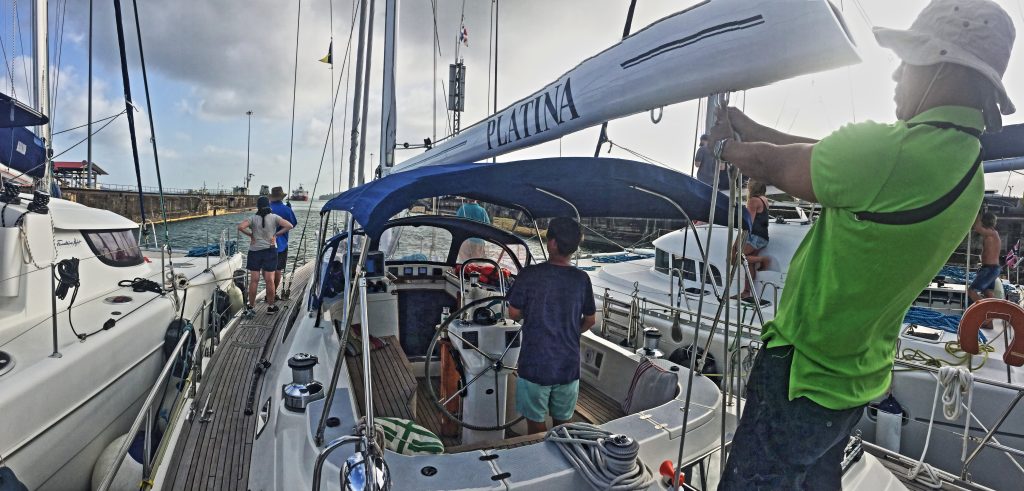
Constructing the Chicken
Panama is fortunate to occupy the narrowest point between the Atlantic and the Pacific Oceans. Back in the 1800s, sailing all the way around Cape Horn was becoming a bit of a drag, so French engineers made the first attempt at digging a short-cut. Unfortunately, it didn’t go well. Finances crumbled, thousands of workers died from Yellow Fever or Malaria and the French threw in the proverbial towel.
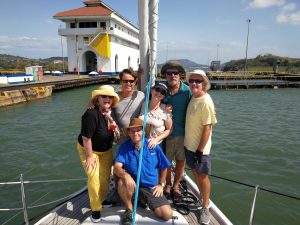
Platina Canal Crew (L-R Juli, David, Marcus, Julie, Chris and Chis)
In 1904 Uncle Sam stepped up with a new design. This time, rather than attempting to cut through Panama’s central high ground for a sea-level canal, they dammed the Río Chagres to form a high lake in a central valley. Ships would ascend from sea-level by a series of locks, cross the lake, then descend again to sea-level by a series of locks at the other end. Genius, huh? It was finally complete in 1914 and still operates today.
Naturally the new short-cut was a hit. High fees were due from each passing ship and the Canal was indeed a ‘Chicken of Golden Eggs’. But for Panama there was one teeny-weeny snaggette: they didn’t control the Chicken and didn’t receive all her golden eggs. Uncle Sam did. Finally, on 31st December 1999 Uncle Sam handed control of the Chicken, and her golden eggs, to Panama.
The final update to the Canal story is that by 2006, larger locks were needed. Panamanians decided by referendum, to invest in a canal expansion programme. The new, wider lock systems were opened in 2016 to operate alongside the old ones.
Finding the Lines
So how did we come to swan through the canal on the fabulous s/v Platina? Well… it’s all about those locks at either end of the canal.
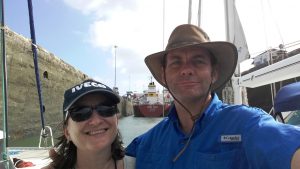
You’ve just got to do a selfie 🙂
When boats ascend/descend through the lock system, they need to be tethered to the lock-side for stability. Fore and aft on either side of each yacht, a line reaches to the lock-side. Each boat therefore needs four line-handlers for the canal transit. Problem is, many yachts don’t have sufficient crew for this. Yachtsmen preparing to transit the canal often advertise in the local marinas seeking line-handlers to assist them through.
In an ideal world, these line-handlers should have previous canal line-handling, or at least yacht-sailing, experience and be au-fait with the ways of the yachting world (particularly knots… these sailors do love their knots 😊). Regrettably, we don’t fit into this category of desirable candidate, but there is an old English saying that ‘if you don’t ask, you don’t get’.
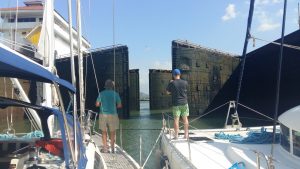
Open Sesame!!
We answered the advert of kindly yachtsmen David and Chis. We were very much aware that, no matter how keen we might be, it’s an extremely ‘Big Ask’ to expect any yacht owner to entrust any handling of their valuable vessel to inexperienced handlers, no matter how small that handling might be. Nevertheless, Canadians David and Chis were kind enough to literally take us on-board, patiently explain the ropes, and welcome us as part of their crew on s/v Platina. Although both very experienced yachtsmen, this was to be their own first ever transit of the Panama Canal, so it was a bit of a leap into the unknown for them too.
So Platina’s crew for the Canal was co-captains David and Chis, chief-crewman Chris (a very experienced British yachtsman who had done the Canal before), Chis’ lovely sister Juli who had flown down from Canada for the experience, and us.
Line-handling… or not
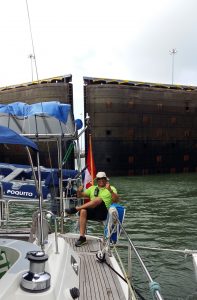
Armado’s in command!
On the day, David skilfully pilots Platina out of the marina to the designated anchorage point – a kind of ‘waiting room’ where small boats gather before moving forward into the canal. Here we are joined on-board by Amádo.
Amádo is a seriously nice chap, but more importantly he’s our designated canal Advisor – it’s his job to guide the captain with yacht handling and canal procedures. Amádo’s arrival brings news that Platina is to be ‘rafted’ with two catamarans: the Norwegian Manajara and the French Vanille. The three boats are lined-up and tied together side-by-side so they can together enter the locks as a single ‘raft’ vessel. This is good news for David and Chis in that being sandwiched between the two cats, they have no risk of Platina being bashed against the lock walls. For us it means that being in the middle, Platina will have no lines to the lock walls, so we won’t get to do the line-handling thing. But it does leave us free to observe, take in the fabulous experience and also a few snaps.
- Heading into the lock, rafted-up to the cats
Transit Time
So… for those curious, here’s a land-lubber’s view of how it goes (any salty sea-dogs out there can see David’s and Chis’ interesting blog on their experience from the captain’s perspective):
- The ‘raft’ of three boats approaches the first set of lock gates under the guidance of Amádo (the catamarans have Advisors too, but Amádo is the senior chap). Winds are quite high and it seems a bit of a tricky manoeuvre to get the raft lined-up, but these guys know what they are doing.
- Inside the lock, we’re floating in a deep hole and it’s a bit intimidating to look up. Ahead of us is the vast steel wall of the colossal container ship sharing our lock-space. To each side of us are the brick side-walls of the lock’s structure. And behind us are the equally high lock gates that are closing to seal us in and form a giant steel barrier for the water. The line-handlers on the two outer sides of the raft, connect their lines with the workers on the lock-side high above us.
- Water floods into the lock and all the boats rise with the water level – quite fortunate that, really… if think about it 😊. As we rise, the line-handlers haul-in their respective lines to maintain tension on the lines and to keep the raft steady between the lock walls. This is what we would have been doing had Platina been either on its own or on the outside of the raft-formation.
- At the top of the lock, we follow the freight ship and float out forwards to do the next lock. It’s not the speediest of processes but finally after three locks, the raft sails out into Lake Gatún some 26 metres higher than the Atlantic Ocean where it entered.
- Wall of steel… in-bound!
- Linehandlers on the cats – what we would have been doing
- Lock-side crew taking the lines
- On the lake, the raft separates to become three individual vessels and we all moor-up to a buoy for the night. Amádo is collected by a staff-boat and we settle down for a delicious meal of barbequed steak and salmon (yes… barbequed… on a yacht!!) by David and Chis. Magnificent.
- Next morning our Advisor arrives and we set-off across Lake Gatún. Today we don’t have Armádo, but the equally amiable Moises. It’s a large lake and under engine power at 7 knots, it takes around four hours to reach the locks to the Pacific.
- Cats… heading to the Pacific.., free from the raft
- Amado going home
- Our lock-mates: two tiny-cats and monster-ship
- The descent is… surprise, surprise… pretty much the opposite of the previous day’s ascent. The three boats form a raft and Platina is again sandwiched between the two cats. This time however, the raft enters the lock ahead of the enormous, correction… ginormous, freight ship (an even bigger one than yesterday). If it was intimidating to tie-up in a lock behind the steel wall that is a 100,000 ton ship, I can now confirm that it is even more intimidating to be tethered-up in a lock with such a freight ship steaming-in behind you! It doesn’t take great nautical expertise to recognise that these monsters can’t stop on a sixpence. Hopefully the tug-trains to which it is tethered on the shore, have its speed and momentum under control… errr…. don’t they???
- As the water drains out of these locks, we descend. This time the line-handlers gradually feed their lines out to maintain stability and tension on the ropes. Once we’re down, the forward gates open and we sail ahead into the next lock to do the same again two more times.
- After we leave the final lock, the raft is untied again. Each of the three boats powers away under the Bridge of the Americas which majestically marks the official entrance to the Pacific Ocean. David steers Platina to moorings in Panama City’s Playita Marina where we all celebrate a job well done by the co-captains.
So there you go. Simples 😊. Well actually…. very much not ‘simples’. It’s an exacting and slightly stressful procedure for David and Chis who admirably maintain their calm and composure all the way through their first Panama Canal transit. The arrival in the Pacific is a momentous step for them on their round-the-world voyage, and it’s an honour for us to share this. We had a fabulous and fascinating time on board s/v Platina, with great company. We wish them all the very best for their Pacific crossing and hope to catch-up with them again somewhere in the world.
Photo credits the whole crew: David Greene, Chis Lyons, Chris Jackman, Juli Lyons (and us 🙂 )
- Moises arrives on board
Notes for Overlanders wanting to sail the Canal
If you’re overlanding through Panama, here are a few pointers if you fancy doing a similar trip:
- To find a place on a yacht, check out the notice boards in the marinas. There are three marinas on the Pacific side near Panama City (Flamingo, Playita and Balboa) and one on the Carribbean/Atlantic side (Shelter Bay across the river from Colon).
- Your chances of getting a place are obviously greater if you have some previous sailing or line-handing experience. But if, like us, you don’t have these skills, you may still find a skipper willing to take you. It may help give the yachtsmen some confidence in you, if you explain that you are an overlander, you are practical/disciplined/resourceful/keen etc.
- Search on-line to learn a few basic nautical knots – we understand that the cleat-hitch and the bowline are the most commonly used and they are very simple to learn.
- Think about truck/boat coordination. Which end will your sailing start? And which end do you want to leave your truck? We think it’s safer to leave your truck at Shelter Bay than it is in Panama City (although it’s probably ok to leave it near the Balboa Marina). It’s easier to get public transport or a taxi from the Panama City end, to Shelter Bay than it is the other way around.
- Make sure you have some time flexibility for the proposed sailing dates. It will probably take two days to get through, but we have heard of some yachts starting very early and going through in a day. The exact dates of the canal transit may change and there can always be delays. Allow at least 2-3 days flex in your programme either side of the yacht’s original proposed transit date.
It’s a fabulous and relatively rare experience. Good luck. And Enjoy!!!
Click here for link how we got to Panama: Darien Gap Vehicle Shipping

